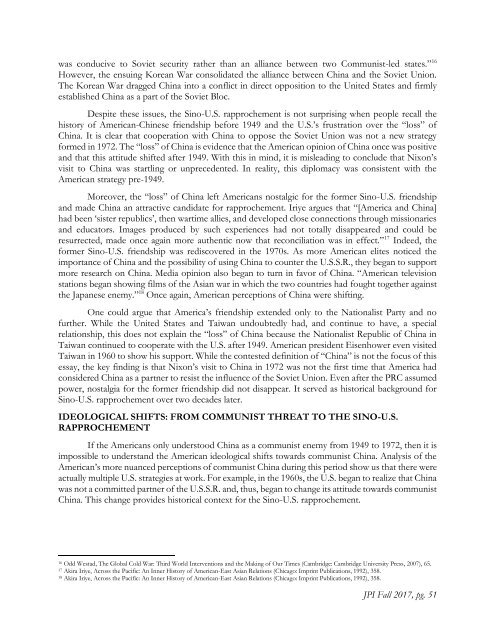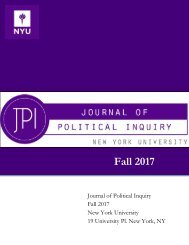JPI Spring 2018
You also want an ePaper? Increase the reach of your titles
YUMPU automatically turns print PDFs into web optimized ePapers that Google loves.
was conducive to Soviet security rather than an alliance between two Communist-led states.” 16<br />
However, the ensuing Korean War consolidated the alliance between China and the Soviet Union.<br />
The Korean War dragged China into a conflict in direct opposition to the United States and firmly<br />
established China as a part of the Soviet Bloc.<br />
Despite these issues, the Sino-U.S. rapprochement is not surprising when people recall the<br />
history of American-Chinese friendship before 1949 and the U.S.’s frustration over the “loss” of<br />
China. It is clear that cooperation with China to oppose the Soviet Union was not a new strategy<br />
formed in 1972. The “loss” of China is evidence that the American opinion of China once was positive<br />
and that this attitude shifted after 1949. With this in mind, it is misleading to conclude that Nixon’s<br />
visit to China was startling or unprecedented. In reality, this diplomacy was consistent with the<br />
American strategy pre-1949.<br />
Moreover, the “loss” of China left Americans nostalgic for the former Sino-U.S. friendship<br />
and made China an attractive candidate for rapprochement. Iriye argues that “[America and China]<br />
had been ‘sister republics’, then wartime allies, and developed close connections through missionaries<br />
and educators. Images produced by such experiences had not totally disappeared and could be<br />
resurrected, made once again more authentic now that reconciliation was in effect.” 17 Indeed, the<br />
former Sino-U.S. friendship was rediscovered in the 1970s. As more American elites noticed the<br />
importance of China and the possibility of using China to counter the U.S.S.R., they began to support<br />
more research on China. Media opinion also began to turn in favor of China. “American television<br />
stations began showing films of the Asian war in which the two countries had fought together against<br />
the Japanese enemy.” 18 Once again, American perceptions of China were shifting.<br />
One could argue that America’s friendship extended only to the Nationalist Party and no<br />
further. While the United States and Taiwan undoubtedly had, and continue to have, a special<br />
relationship, this does not explain the “loss” of China because the Nationalist Republic of China in<br />
Taiwan continued to cooperate with the U.S. after 1949. American president Eisenhower even visited<br />
Taiwan in 1960 to show his support. While the contested definition of “China” is not the focus of this<br />
essay, the key finding is that Nixon’s visit to China in 1972 was not the first time that America had<br />
considered China as a partner to resist the influence of the Soviet Union. Even after the PRC assumed<br />
power, nostalgia for the former friendship did not disappear. It served as historical background for<br />
Sino-U.S. rapprochement over two decades later.<br />
IDEOLOGICAL SHIFTS: FROM COMMUNIST THREAT TO THE SINO-U.S.<br />
RAPPROCHEMENT<br />
If the Americans only understood China as a communist enemy from 1949 to 1972, then it is<br />
impossible to understand the American ideological shifts towards communist China. Analysis of the<br />
American’s more nuanced perceptions of communist China during this period show us that there were<br />
actually multiple U.S. strategies at work. For example, in the 1960s, the U.S. began to realize that China<br />
was not a committed partner of the U.S.S.R. and, thus, began to change its attitude towards communist<br />
China. This change provides historical context for the Sino-U.S. rapprochement.<br />
16<br />
Odd Westad, The Global Cold War: Third World Interventions and the Making of Our Times (Cambridge: Cambridge University Press, 2007), 65.<br />
17<br />
Akira Iriye, Across the Pacific: An Inner History of American-East Asian Relations (Chicago: Imprint Publications, 1992), 358.<br />
18<br />
Akira Iriye, Across the Pacific: An Inner History of American-East Asian Relations (Chicago: Imprint Publications, 1992), 358.<br />
<strong>JPI</strong> Fall 2017, pg. 51
















